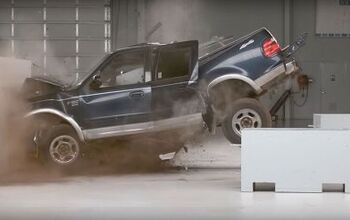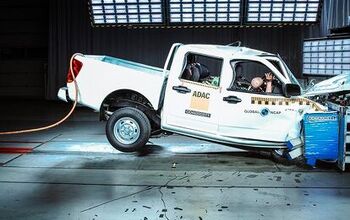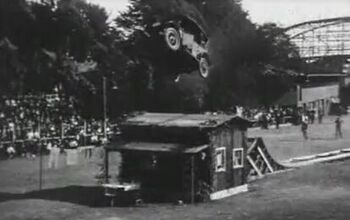4 Views
That's Not A Crash Test, This Is A Crash Test
by
Edward Niedermeyer
(IC: employee)
Published: July 25th, 2011
Share
If you don’t speak German, you can go ahead and skip to 1:30, where the magic happens. Essentially, the German safety nuts at the ADAC and DEKRA have been trying to scare motorists silly for some time now, shaming automakers and educating motorists about the dangers they face every day. The latest terror: a semi truck plowing into you from behind at about 43 MPH. The results? Well, they speak for themselves. The reason? Illustrating the need for Emergency Brake Assist in large trucks, which the ADAC argues should be mandatory for all trucks [per Autobild]. Though this does seem to be something of a case of legislating against stupidity, the ADAC certainly make a vivid argument for their cause…
Edward Niedermeyer
More by Edward Niedermeyer
Published July 25th, 2011 8:34 PM

































Comments
Join the conversation
So the Germans don't have their own terms for crash test?
Clearly 90's european cars are no where close to as robust as late 70's US cars if BHC is to be believed http://youtu.be/iy4nqWw_trU
Fascinating. Reminds me a lot of the horrifying crash test images of his '89 Vauxhall Nova that had my Dad rushing off to the dealerships in the early 90s... hardly surprising really since the Megane used in the test is a 1988 design (the Megane I being a light reskin of the old Renault 19). In my experience cars this old have almost all been crushed long-since by more conventional measures in a scrap yard. Here in Edinburgh it's unusual to see many cars older than 10-12 years still on the road unless it's a "classic" (or something someone hopes will one day be a classic...) What would have been really interesting would have been a comparison video showing the results of an identical test with a couple of c.1998 designs and then a couple of c.2008 designs... kind of an evolution of crash protection?
To my mind, several things are wrong with this crash test: - old cars, from before the time of boron-steels and the like, as well as competent rear crush-zone design; - fixed and rigid barrier that is non-deformable, non-rotatable, non-translatable, any of which is, let-alone all of which are, not a good representation of the real world; - old truck which may not be good representation of current truck crush features. As to the purpose, to require pre-warn and active braking systems on the big rigs, I applaud the intent. Systems that trigger moderate braking to adjust the front-gap, and hard-braking to prevent rapid closure and collision would save lives, and when added to the cost of a modern truck represent a mere pittance. Design-wise, it would be relatively simple to overlay these feature onto the existing hardware in the heavy-vehicles's ABS/ESP systems with some additional hardware (mostly distance sensing-unit) and adaption of the controls to reflect the reality a heavy truck's operative envelope (namely cars scooting in and out and across the front of the heavy's path). One additional feature would have to be signs on the rear, which warn following vehicles to "Back-Off", such that if emergency braking was triggered by an event in front of the truck, that this would not result in inducing a rear-end collision or "ride-under". Overall, such a system could prevent crashes, and all the related costs (death, injury, scrappage, repair, time-out-of-service, rescue and evacuation costs, secondary-accidents within the jam behind the initial accident, and time-loss due to sitting in a traffic jam caused by some accident at the front of the jam.) Given the repeating reality of accidents on motorways, I'm all for this kind of technology. And contrary to the dreams of the folks in the motoring community (which say seemingly arrogant and silly things like: "legislating against stupidity" to marginalize the idea, or promote some laissz faire idea of a motorist's, or passenger's, responsibilities) which given reality, do nothing to address the roulette-players chance of being involved in such an accident. Investigating the mandatory installation of such systems, and (if justified by a proper CBA) spreading the costs of prevention amongst all of us is a superior alternative to similarly spreading the costs of an accident.